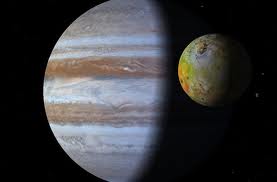Venus Moons

Venus was once thought to have a moon, named Neith after the chief goddess of Sais, Egypt, and first observed in the year by Giovanni Domenico Cassini. German astronomers called the moon Kleinchen (literally “tiny”), and patchy sightings by astronomers continued until 1892.
These sightings have since been discredited, and are thought to have been mostly faint stars that happened to be in the right place at the right time or maybe even asteroids passing by the planet. Venus is now known to be moonless.
Venus Landing
Venera 3 the Soviet space probe crash-landed on Venus, becoming the first spacecraft to arrive at the planet‘s surface in 1966 of March 1. Its sister craft Venera 2 had failed from overheating shortly before completing its flyby mission.
The descent capsule of Venera 4 entered the atmosphere of Venus on October 18, 1967. The first probe to return direct measurements from another planet, the capsule deliberated temperature, pressure, density and performed 11 automatic chemical experiments to examine the atmosphere. It showed 95% carbon dioxide, and in combination with radio supernatural data from the Mariner 5 probe, it showed that surface pressures were far greater than expected (75 to 100 atmospheres).
These results were confirmed and refined by the Venera 5 and Venera 6 missions on May 16 and 17 of 1969. However none of these missions had reached the surface whereas still transmitting. Venera 4’s battery ran out while gradually floating through the massive atmosphere, and Venera 5 and 6 were crushed by high pressure 18 km (60,000 ft) above the surface.
The first successful landing on Venus was by Venera 7 on December 15, 1970. It relayed surface temperatures of 455 °C to 475 °C (855 °F to 885 °F). Venera 8 landed on July 22, 1972. Besides pressure and temperature profiles, a photometer showed that the clouds of Venus formed a layer, ending over 22 miles above the surface. A gamma ray spectrometer analyzed the chemical composition of the crust.
Observation of Venus
Venus is the most well-known astronomical feature in Earth’s morning and evening sky (other than the Sun and Moon), and has been known from the past. One of the oldest surviving astronomical documents, from the Babylonian library of Ashurbanipal around 1600 BC, is a 21-year record of the appearances of Venus (which the early Babylonians called Nindaranna). The ancient Sumerians and Babylonians called Venus Dil-bat or Dil-i-pat; in Akkadia it was the special star of the mother-god Ishtar; and in Chinese it is Jin-xing (??), the planet of the metal element.

In India, Venus is called Shukra Graha (the planet Shukra) which is named after a powerful saint Shukra. The word ‘Shukra’ also associated with semen, or generation.Venus as a brilliant “Evening Star” next to crescent moon.Venus was considered as the most important celestial body observed by the Maya, who called it Chak ek, “the Great Star”, possibly more important even than the Sun.
The Mayans monitored the activities of Venus intimately and observed it in daytime. The positions of Venus and other planets were thought to influence life on Earth, so Maya and other ancient Mesoamerican cultures timed wars and other important events based on their observations. In the Dresden Codex, the Maya included an manual showing Venus’s full cycle, in five sets of 584 days each (approximately eight years), after which the patterns repeated (since Venus has a synodic period of 583.92 days).
At the half-full phase Venus is at greatest elongation – east of the Sun when an evening star and west of the Sun as a morning star. The precise angle the planet makes with the Sun at this point in time varies approximately from 45.0° to 47.8° depending on whether Earth and Venus are at perihelion or aphelion. This range is much lesser than that of Mercury because Venus’s orbit is far less eccentric than Mercury’s.
Solar System | Mercury | Venus Moons | Earth | Mars Moons | Jupiter Moons | Saturn Moons | Uranus Moons | Neptune Moons | International Space System | ISS Research | Moons of the planet | Magnetosphere | Regions Of Comets | Space Station Glossary | Space Station Abbreviation | Space Station Sitemap | Asteriods | Contact Us